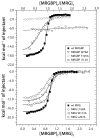Structural Basis for Multi-specificity of MRG Domains
- PMID: 25960410
- PMCID: PMC4456287
- DOI: 10.1016/j.str.2015.03.020
Structural Basis for Multi-specificity of MRG Domains
Abstract
Chromatin-binding proteins play vital roles in the assembly and recruitment of multi-subunit complexes harboring effector proteins to specific genomic loci. MRG15, a chromodomain-containing chromatin-binding protein, recruits diverse chromatin-associated complexes that regulate gene transcription, DNA repair, and RNA splicing. Previous studies with Pf1, another chromatin-binding subunit of the Sin3S/Rpd3S histone deacetylase complex, defined the sequence and structural requirements for interactions with the MRG15 MRG domain, a common target of diverse subunits in the aforementioned complexes. We now show that MRGBP, a member of the Tip60/NuA4 histone acetyltransferase complex, engages the same two surfaces of the MRG domain as Pf1. High-affinity interactions occur via a bipartite structural motif including an FxLP sequence motif. MRGBP shares little sequence and structural similarity with Pf1, yet targets similar pockets on the surface of the MRG domain, mimicking Pf1 in its interactions. Our studies shed light onto how MRG domains have evolved to bind diverse targets.
Copyright © 2015 Elsevier Ltd. All rights reserved.
Conflict of interest statement
The authors declare no conflicts of interest.
Figures




Similar articles
-
Structural basis for molecular interactions involving MRG domains: implications in chromatin biology.Structure. 2012 Jan 11;20(1):151-60. doi: 10.1016/j.str.2011.10.019. Structure. 2012. PMID: 22244764 Free PMC article.
-
Sequence requirements for combinatorial recognition of histone H3 by the MRG15 and Pf1 subunits of the Rpd3S/Sin3S corepressor complex.J Mol Biol. 2012 Sep 28;422(4):519-31. doi: 10.1016/j.jmb.2012.06.013. Epub 2012 Jun 21. J Mol Biol. 2012. PMID: 22728643 Free PMC article.
-
Multipurpose MRG domain involved in cell senescence and proliferation exhibits structural homology to a DNA-interacting domain.Structure. 2006 Jan;14(1):151-8. doi: 10.1016/j.str.2005.08.019. Structure. 2006. PMID: 16407074
-
Histone deacetylases: complex transducers of nuclear signals.Semin Cell Dev Biol. 1999 Apr;10(2):179-88. doi: 10.1006/scdb.1999.0299. Semin Cell Dev Biol. 1999. PMID: 10441071 Review.
-
Structural and functional insights into the epigenetic regulator MRG15.Acta Pharmacol Sin. 2024 May;45(5):879-889. doi: 10.1038/s41401-023-01211-6. Epub 2024 Jan 8. Acta Pharmacol Sin. 2024. PMID: 38191914 Free PMC article. Review.
Cited by
-
Structural Insight into the Mechanism of PALB2 Interaction with MRG15.Genes (Basel). 2021 Dec 17;12(12):2002. doi: 10.3390/genes12122002. Genes (Basel). 2021. PMID: 34946951 Free PMC article.
-
A Novel Mechanism of Coactivator Recruitment by the Nurr1 Nuclear Receptor.J Mol Biol. 2022 Aug 30;434(16):167718. doi: 10.1016/j.jmb.2022.167718. Epub 2022 Jul 8. J Mol Biol. 2022. PMID: 35810793 Free PMC article.
-
Regulation and function of H3K36 di-methylation by the trithorax-group protein complex AMC.Development. 2018 Apr 5;145(7):dev163808. doi: 10.1242/dev.163808. Development. 2018. PMID: 29540501 Free PMC article.
-
Structures of H2A.Z-associated human chromatin remodelers SRCAP and TIP60 reveal divergent mechanisms of chromatin engagement.bioRxiv [Preprint]. 2024 Jul 30:2024.07.30.605802. doi: 10.1101/2024.07.30.605802. bioRxiv. 2024. PMID: 39131301 Free PMC article. Preprint.
-
Biochemical Characterization of the TINTIN Module of the NuA4 Complex Reveals Allosteric Regulation of Nucleosome Interaction.Mol Cell Biol. 2022 Nov 17;42(11):e0017022. doi: 10.1128/mcb.00170-22. Epub 2022 Oct 3. Mol Cell Biol. 2022. PMID: 36190236 Free PMC article.
References
-
- Bax A, Grzesiek S. Methodological advances in protein NMR. Accounts Chem Res. 1993;26:131–138.
-
- Bowman BR, Moure CM, Kirtane BM, Welschhans RL, Tominaga K, Pereira-Smith OM, Quiocho FA. Multipurpose MRG domain involved in cell senescence and proliferation exhibits structural homology to a DNA-interacting domain. Structure. 2006;14:151–158. - PubMed
-
- Brünger AT, Adams PD, Clore GM, DeLano WL, Gros P, Grosse-Kunstleve RW, Jiang JS, Kuszewski J, Nilges M, Pannu NS, et al. Crystallography & NMR system: A new software suite for macromolecular structure determination. Acta Crystallogr D Biol Crystallogr. 1998;54:905–921. - PubMed
-
- Cai Y, Jin J, Tomomori-Sato C, Sato S, Sorokina I, Parmely TJ, Conaway RC, Conaway JW. Identification of new subunits of the multiprotein mammalian TRRAP/TIP60-containing histone acetyltransferase complex. J Biol Chem. 2003;278:42733–42736. - PubMed
Publication types
MeSH terms
Substances
Associated data
- Actions
Grants and funding
LinkOut - more resources
Full Text Sources
Other Literature Sources
Molecular Biology Databases
Miscellaneous

